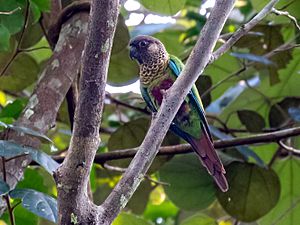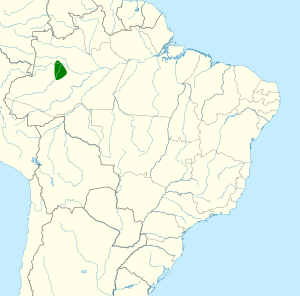Bonaparte's parakeet facts for kids
Quick facts for kids Bonaparte's parakeet |
|
|---|---|
 |
|
| Conservation status | |
| Scientific classification | |
 |
|
| Synonyms | |
|
Pyrrhura picta lucianii |
The Bonaparte's parakeet (Pyrrhura lucianii), also called Deville's parakeet, is a type of parrot. It belongs to the family called Psittacidae. This bird lives only in the Brazilian state of Amazonas, specifically south of the Solimões river.
Contents
What Does It Look Like?
This parakeet is about 22 centimetres (8.7 in) long. Like other parakeets in its group, it has a long tail and is mostly green. Its belly, rump, and the tip of its tail are dark red. From underneath, its tail looks completely dark red.
Its chest has pale grey scales, and it has a whitish or dull buff patch near its ears. The feathers on its wings are bluish. The cheeks and the top of its head (crown) are a dark, dusky-maroon color, which often looks almost black. Unlike some other parakeets in its group, it doesn't have bright red or blue colors on its head. Its legs are dark grey.
Where It Lives and What It Does
Bonaparte's parakeet lives in warm, wet lowland forests and nearby areas. These birds are very social. You will usually see them in pairs or small groups.
They like to eat fruits, seeds, and flowers. When it's time to nest, they find a hole in a tree to lay their eggs. These parakeets are probably quite common where they live. However, not many scientists have studied them because the areas they live in are very remote.
How Scientists Classify It
Scientists group living things based on how they are related. This is called taxonomy. For a long time, the Bonaparte's parakeet was thought to be a subspecies of another parakeet called Pyrrhura picta.
However, scientists are always learning new things. Based on new studies, many experts now believe that Pyrrhura lucianii (Bonaparte's parakeet) should be considered its own unique species. This means it's not just a type of Pyrrhura picta, but a distinct bird all on its own.
Sometimes, scientists find that birds that look similar are actually more closely related to different groups. This can change how they classify them. The exact relationships between Bonaparte's parakeet and some other similar parakeets are still being studied.
For example, there's a group of these parakeets in northeastern Peru. They have some red on their foreheads. Scientists are still trying to figure out if these birds are a separate species, a subspecies of Bonaparte's parakeet, or perhaps a mix of different types. It shows that understanding the bird world is a big puzzle that scientists are still working to solve!
See also
 In Spanish: Cotorra de Bonaparte para niños
In Spanish: Cotorra de Bonaparte para niños


